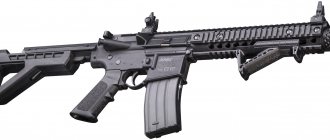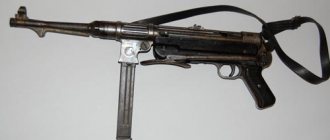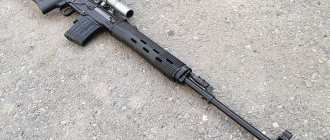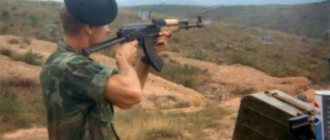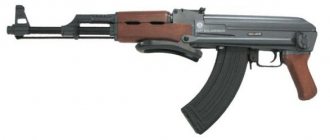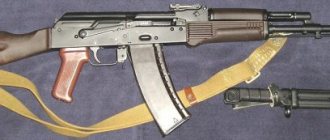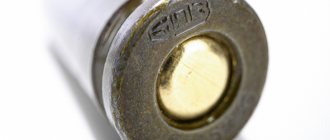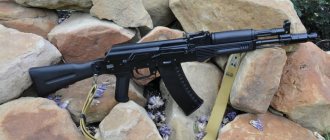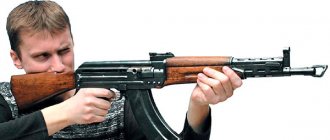Penetrating effect of bullets
| № | Name of the barrier (protective equipment) | Bullet type | Firing range, m | Percentage of through holes or penetration depth |
| 1 | Armor 7 mm thick at a meeting angle of 90° | Armor-piercing incendiary bullet | 300 200 | 50% 90% |
| 2 | Hard hat (steel helmet) | Steel core bullet Armor-piercing incendiary bullet | 900 Over 1100 | 80-90% 80-90% |
| 3 | Body armor | Steel cored bullet Armor-piercing incendiary bullet | 600 1000 | 80—90% 80—90% |
| 4 | A parapet made of densely compacted snow | All types of bullets | 500 | 70-80 cm |
| 5 | An earthen barrier made of loose sandy loam soil | Same | 500 | 25-30 cm |
| 6 | Dry pine beams 20x20 cm, fastened in stacks | Bullet with a steel core and armor-piercing incendiary | 500 150 | 25 cm 30-40 cm |
| 7 | Brickwork | Same | 100 | 12-15 cm |
Main table
Bullet weight 7.9 g
Initial speed 715 m/s
Departure angle minus 2 m
Muzzle energy 207 kgm
| Range | Aiming angle | Angle of incidence | Path height | Horizontal distance to the top of the trajectory | Total bullet flight time | Final bullet speed | Bullet energy at impact point | Range | ||||
| m | g min | thousand | g min | thousand | m | m | With | m/s | kgm | m | ||
| 100 | 0 | 07 | 1,9 | 0 | 04 | 1,1 | 0,03 | 51 | 0,15 | 623 | 157 | 100 |
| 200 | 0 | 11 | 3,1 | 0 | 09 | 2,5 | 0,13 | 105 | 0,32 | 537 | 117 | 200 |
| 300 | 0 | 16 | 4,4 | 0 | 18 | 5,0 | 0,34 | 162 | 0,52 | 459 | 86 | 300 |
| 400 | 0 | 22 | 6,1 | 0 | 31 | 8,6 | 0,71 | 221 | 0,76 | 391 | 63 | 400 |
| 500 | 0 | 31 | 8,6 | 0 | 48 | 13 | 1,3 | 282 | 1,04 | 334 | 47 | 500 |
| 600 | 0 | 42 | 12 | 1 | 09 | 19 | 2,3 | 344 | 1,35 | 304 | 37 | 600 |
| 700 | 0 | 54 | 15 | 1 | 35 | 26 | 3,7 | 406 | 1,69 | 284 | 32 | 700 |
| 800 | 1 | 08 | 19 | 2 | 06 | 35 | 5,5 | 468 | 2,05 | 266 | 29 | 800 |
Vietnam War
The AK also became one of the symbols of the Vietnam War, during which it was widely used by soldiers of the North Vietnamese army and partisans of the National Front. In the unfavorable conditions of the jungle, the M16 “black rifles”, due to the command’s economy on the quality of gunpowder, quickly broke down, and their repair was difficult, as a result of which American soldiers sometimes replaced them with captured AKs.
Afghanistan
In Afghanistan, the 56th Air Assault Brigade,
The war in Afghanistan has accelerated the spread of AKs throughout the world. Now rebels and terrorists were armed with it. The CIA generously provided the Mujahideen with Kalashnikov assault rifles, mostly Chinese-made (in the PRC, AKs under the designation Type 56 were produced in huge quantities under license), through Pakistan. The AK was a cheap and reliable weapon, which is why the US preferred it.
Even before the withdrawal of Soviet troops, Western media paid attention to the large number of AKs in the region, and the concept of “Kalashnikov Culture” entered the lexicon. After the last Soviet units left Afghanistan on February 15, 1989, the developed weapons infrastructure of the Mujahideen did not disappear anywhere, but, on the contrary, was integrated into the economy and culture of the region
For example, almost the entire shadow economy of Pakistan (groups of robbers and kidnappers, drug lords, village arms dealers) was directly dependent on AK. It should be noted that the leader of the Afghan Mujahideen and sworn enemy of the Soviet troops, Ahmad Shah Massoud, when asked: “What weapon do you prefer?”, answered: “Kalashnikov, of course.”
After the entry of NATO troops into Afghanistan, the Americans were forced to face the same AKs that the CIA purchased for the Mujahideen. According to the Washington Post, Sergeant 1st Class Nathan Ross Chapman, who was shot with a Kalashnikov assault rifle by an Afghan teenager, became the first American to die in this war from enemy fire (according to the independent Internet site iCasualties.org, the first American to die in Afghanistan from enemy fire, was Johnny Spann
Iraq War
To the surprise of the coalition forces, the soldiers of the newly created Iraqi army refused the American M16 and M4, demanding AKs. According to Walter B. Slocombe, a senior adviser to the Coalition Provisional Authority, "anyone in Iraq over the age of 12 can take it apart and put it back together with their eyes closed and shoot it pretty well."
US Marine with MPi-KMS-72, the East German equivalent of the AKMS
After the collapse of the USSR
After the collapse of the USSR, many ATS countries began to sell off their arsenals, but this did not lead to a collapse in AK prices. A noticeable decrease in the cost of a machine gun from approximately $1,100 to $800 at the turn of the 1980s–1990s occurred only in the Middle East; in Asia and America prices even increased (from approximately $500 to $700), and in Eastern Europe and Africa they remained virtually unchanged ( about 200-300 $)
Venezuela
In 2005, Venezuelan President Hugo Chavez decided to sign a contract with Russia for the supply of 100 thousand AK-103 assault rifles. The contract was completed in 2006, but Hugo Chavez is already talking about his readiness to purchase another 920 thousand assault rifles and is negotiating the establishment of licensed production of the AK-103 in the country. Hugo Chavez calls the main reason for increasing arms purchases “the threat of an American military invasion.”
Excess of trajectories above the aiming line
Bullet weight 7.9 g
Initial speed 715 m/s
| Range m Aim | 50 | 100 | 150 | 200 | 250 | 300 | 350 | 400 | 450 | 500 | 550 | 600 | Range m Aim |
| Centimeters | |||||||||||||
| 1 | 0 | 0 | -7 | -20 | — | — | — | — | — | — | — | — | 1 |
| 2 | 5 | 10 | 9 | 0 | -17 | -45 | — | — | — | — | — | — | 2 |
| 3 | 13 | 25 | 31 | 30 | 20 | 0 | -31 | -77 | — | — | — | — | 3 |
| 4 | 22 | 44 | 60 | 69 | 68 | 57 | 35 | 0 | -52 | -123 | — | — | 4 |
| 5 | 34 | 68 | 96 | 116 | 127 | 129 | 119 | 95 | 55 | 0 | -83 | -187 | 5 |
| Range m Aim | 100 | 200 | 300 | 400 | 500 | 600 | 700 | 800 | 900 | 1000 | Range m Aim |
| Meters | |||||||||||
| 6 | 0,98 | 1,8 | 2,2 | 2,1 | 1,4 | 0 | -2,7 | -6,4 | — | — | 6 |
| 7 | 1,3 | 2,5 | 3,3 | 3,6 | 3,2 | 2,1 | 0 | -3,5 | -8,4 | — | 7 |
| 8 | 1,8 | 3,4 | 4,6 | 5,4 | 5,5 | 4,7 | 3,0 | 0 | -4,5 | -10,5 | 8 |
Kalashnikov assault rifle AKM / AKMS / AKMN / AKMSN
| Kalashnikov assault rifle modernized AKM early release |
| serial Kalashnikov assault rifle modernized AKMS with folding stock |
The strength of the receiver cover was increased by transverse stiffening ribs.
Instead of a detachable blade bayonet, a universal bayonet mod.1 was introduced, suitable for use as a file, and together with a sheath with a rubber (on mod.2 - plastic) lining - as scissors for cutting barbed wire and live wire. The length of the blade was 150, width – 30 mm.
| serial Kalashnikov assault rifle modernized AKM with compensator, light alloy magazine and bayonet |
Based on the results of tests in 1959, the new “7.62-mm Kalashnikov assault rifle modernized AKM” was adopted into service by the Soviet Army, as it demonstrated high reliability, acceptable characteristics in terms of accuracy and accuracy of fire, while an important role was played by the fact that the Kalashnikov assault rifle had previously been fully mastered as industry and the military.
In addition to the basic AKM model, a number of modifications were created on its basis: - AKMS - a variant of the AKM with a folding metal butt. — AKMN – AKM variant with the ability to use night sights. - AKMSN - AKMN variant with a folding metal butt.
| serial Kalashnikov assault rifle modernized AKMN with a compensator, a plastic magazine, a bayonet and a rail for installing a night sight |
| serial Kalashnikov assault rifle modernized AKMN with NSPU night vision sight |
| serial Kalashnikov assault rifle modernized AKMSN with night vision sight NSP-ZA |
| serial Kalashnikov assault rifle, modernized AKM with silent firing device PBS-1 |
The machine's sights consist of an adjustable (for zeroing) front sight in the front sight and an adjustable rear sight, marked at a range of 1000 meters (in AKs up to 800 meters).
Models AKMN and AKMSN, due to the installation of a dovetail mount on the left side of the receiver, are adapted for the installation of illuminated (NSP-2) and non-illuminated (NSP-3, later NSPU, NSPUM, NSPU-3) night sights.
| AKM | AKMS | |
| Caliber, mm | 7.62x39 | |
| Length, mm - butt unfolded - butt folded | 880 —— | 880 640 |
| Barrel length, mm | 415 | |
| Weight, kg - without magazine - with loaded magazine | 2.93 3.60 | 3.13 3.80 |
| Store, count. cartridges | 30 | |
| Initial bullet speed, m/s | 715 | |
| Sighting range, m | 500 | |
| Rate of fire, rds/min | 600 | |
| Combat rate of fire, rds/min | 100 | |
Modifications of AKMS assault rifles specially developed for the Airborne Forces had folding butts made of stamped steel profiles. Such butts were folded down and forward, under the receiver; accessories for such machine guns were carried separately.
The AKM is equipped with a bayonet in a sheath and a gun belt. The machine also has the ability to install a 40-mm grenade launcher.
Since the Kalashnikov scheme at the end of the 1950s emerged as the winner in the competition to create a unified small arms system based on a single model, in addition to the AKM and its modifications AKMS, AKMN, AKMSN, machine guns created on the basis of the modernized Kalashnikov assault rifle were adopted into service by the Soviet Army: - RPK - Kalashnikov light machine gun. - RPKS - Kalashnikov light machine gun with a folding butt. - RPKN and RPKSN - light machine guns that allow the installation of night sights. - PKT - Kalashnikov tank machine gun.
As a result of the adoption of AKM and RPK, a 7.62-mm family of weapons was formed: on the basis of the main components and parts, machine guns (24 nodes, 95 parts) AKM, AKMS, AKMN and AKMSN, light machine guns (33 nodes, 163 parts) RPK were manufactured , RPKS, RPKN and SSBN. At the same time, 10 units and 80 parts were unified throughout the entire family.
The main manufacturers of Kalashnikov assault rifles were the Izhevsk and Vyatsko-Polyansky machine-building plants.
| serial Kalashnikov assault rifle, modernized AKM with an under-barrel 40-mm grenade launcher GP-25 |
In 1974, the Soviet Army adopted a new 5.45-mm rifle complex, consisting of an AK-74 assault rifle and an RPK-74 light machine gun, and the production of AKM assault rifles in the USSR was curtailed.
However, a significant number of 7.62-mm AKM assault rifles remained in service with various branches of the army and the Ministry of Internal Affairs, both in Russia and the former republics of the USSR.
Source
Dispersion characteristics
Steel core bullet
Shooting in short bursts while lying down or standing from a trench
| Range m | Average deviation (Vv, Vb ) and core bands ( | |||||||||
| The first bursts of bullets | Subsequent bursts of bullets | |||||||||
| Pul | Average hit points | Total | ||||||||
| in height | lateral | in height | lateral | in height | lateral | in height | lateral | in height | lateral | |
| Вв1 | Vb1 | Vv | Wb | Vv stp | Wb stp | BB sum | Wb sum | St. | Sat | |
| Meters | ||||||||||
| 100 | 0,04 | 0,03 | 0,06 | 0,09 | 0,05 | 0,07 | 0,08 | 0,11 | 0,24 | 0,34 |
| 200 | 0,08 | 0,07 | 0,11 | 0,18 | 0,10 | 0,13 | 0,15 | 0,22 | 0,46 | 0,68 |
| 300 | 0,12 | 0,11 | 0,17 | 0,27 | 0,15 | 0,20 | 0,23 | 0,33 | 0,70 | 1,01 |
| 400 | 0,17 | 0,15 | 0,23 | 0,36 | 0,20 | 0,27 | 0,31 | 0,44 | 0,95 | 1,35 |
| 500 | 0,21 | 0,18 | 0,29 | 0,45 | 0,26 | 0,33 | 0,39 | 0,56 | 1,19 | 1,71 |
| 600 | 0,26 | 0,22 | 0,35 | 0,54 | 0,31 | 0,40 | 0,47 | 0,67 | 1,44 | 2,05 |
| 700 | 0,32 | 0,26 | 0,42 | 0,63 | 0,36 | 0,46 | 0,55 | 0,78 | 1,69 | 2,39 |
| 800 | 0,38 | 0,31 | 0,49 | 0,72 | 0,41 | 0,53 | 0,61 | 0,90 | 1,96 | 2,75 |
Note. When shooting with single fire
the dispersion characteristics correspond to the dispersion characteristics of the first bullets of the Vv1 Vb1 bursts
APPLICATION IN THE WORLD
Geography of distribution of Kalashnikov assault rifles: AK operators, operators of only modernized assault rifles in the country, producing/producing their own variants based on AK
AK is so cheap to produce and widespread throughout the world that in some countries it costs less than live chicken. It can be seen in reports from almost any hot spot in the world. The AK is in service with the regular armies of more than fifty countries around the world, as well as countless terrorist groups and just gangs. The AK was and remains the deadliest weapon on Earth: its bullets kill a quarter of a million people every year. During the Cold War, the United States and the Soviet Union competed for spheres of influence around the world, including through arms supplies. The AK was noticeably superior to the American M1 Garand and M14 rifles in terms of reliability and ease of maintenance, making it much more suitable for poor countries that did not have a developed weapons infrastructure.
In addition, “brotherly countries”, for example, Bulgaria, Hungary, East Germany, China, Poland, North Korea and Yugoslavia, received licenses for the production of AKs free of charge. It doesn’t take long to learn how to use an AK (the full army training course in using an assault rifle is only 10 hours), which explains why the assault rifle is so widespread among partisans, rebels and terrorists.
First combat use
The first case of mass combat use of AKs on the world stage occurred on November 1, 1956, during the suppression of the uprising in Hungary. Until this moment, the machine gun was hidden from prying eyes in every possible way: the soldiers carried it in special cases that concealed the outlines, and after the shooting, all the cartridges were carefully collected. The AK has proven itself well in urban combat.
Number of rounds required to hit one target
| Range m | Head figure | Chest figure | Waist figure | running figure | Running figure profile | Machine gun | Rocket anti-tank gun | Anti-tank gun |
| 100 | 3/1 | 3/1 | 3 | 3/1 | 3/1 | 3/1 | 3/1 | 3/1 |
| 200 | 4/2 | 3/1 | 3/1 | 3/1 | 3/1 | 3/1 | 3/1 | 3/1 |
| 300 | 6/3 | 4/2 | 4/1 | 4/1 | 4/1 | 4/2 | 3/1 | 3/1 |
| 400 | 9/4 | 6/3 | 4/2 | 4/2 | 5/2 | 5/2 | 3/1 | 3/1 |
| 500 | 13/6 | 9/4 | 5/2 | 5/2 | 6/2 | 6/3 | 4/2 | 3/1 |
| 600 | 12/5 | 6/3 | 6/2 | 7/3 | 8/4 | 5/2 | 4/2 | |
| 700 | 16/7 | 8/4 | 7/3 | 9/4 | 11/5 | 6/2 | 4/2 | |
| 800 | 11/5 | 9/4 | 11/5 | 15/7 | 7/3 | 5/2 |
Numerator - when firing in short bursts; denominator - When firing with single fire.
Notes:
1. When shooting at a moving target, the number of rounds increases by 1.3 times.
2. When shooting at night or at targets located on the water, the number of rounds increases by 1.5 times.
3. When firing from landing craft, the number of rounds increases by 2 times.
4. When shooting from a position, lying down from the hand or from the knee and on the move from a short stop or standing, the number of cartridges increases accordingly: at a range of 100 m by 1.3 and 1.8 times, at a range of 200 m by 1.6 and 2.3 times, at longer ranges - 2 times.
Operating countries
Geography of AK-74 distribution: AK-74 operators
- Azerbaijan: in 2010, Russia and Azerbaijan entered into a contract to organize licensed production of modernized Khazri assault rifles in Azerbaijan.
- Afghanistan
- Armenia
- Belarus
- Bulgaria
- Hungary: Replica of the AK-74 designated NGM-81.
- GDR: Clones of the AK-74, AKS-74 and AKS-74U were produced and were in service under the designations MPi-AK-74N, MPi-AKS-74N and MPi-AKS-74NK, respectively.
- Germany: After the reunification of Germany, they were adopted by the Bundeswehr as weapons of a limited standard.
- Georgia
- Greece: AK-74M
- Jordan
- Iraq: Variant Kbk wz. 88 Tantal.
- Kazakhstan
- Kyrgyzstan
- Cuba
- Moldova
- Mongolia
- DPRK: A copy of the AK-74 under the designation Type 98.
- Poland: Kbk wz variants. 88 Tantal and Kbs wz.96 Beryl.
- Romania: Option PA md. 1986.
- Russia: Several million, it is planned to gradually dispose of weapons that have reached their end of life. But until the planned mass production reaches the required number of the new machine gun, which passed state tests in 2013-2014, the Russian Ministry of Defense is working on a plan to modernize the remaining types of AK-74 to AK-74M3 to extend operation indefinitely.
- USSR
- Syria
- Tajikistan
- Turkmenistan
- Ukraine
- Uzbekistan
- Philippines
- Estonia
